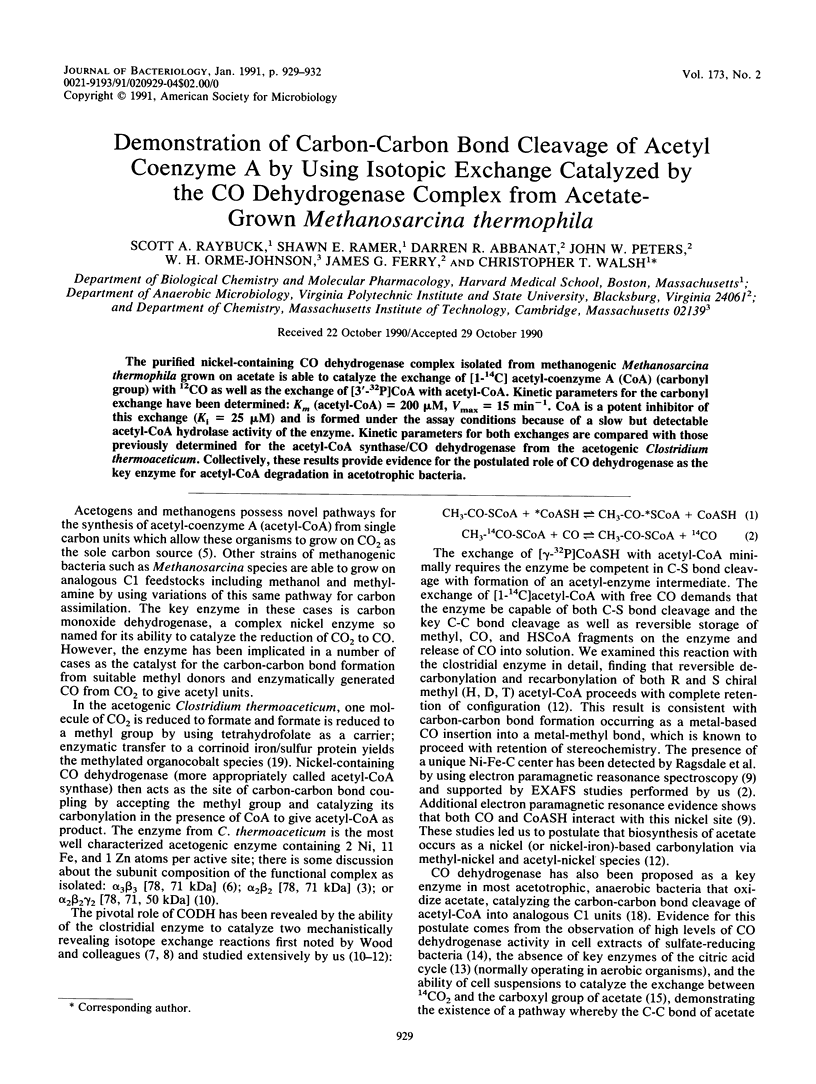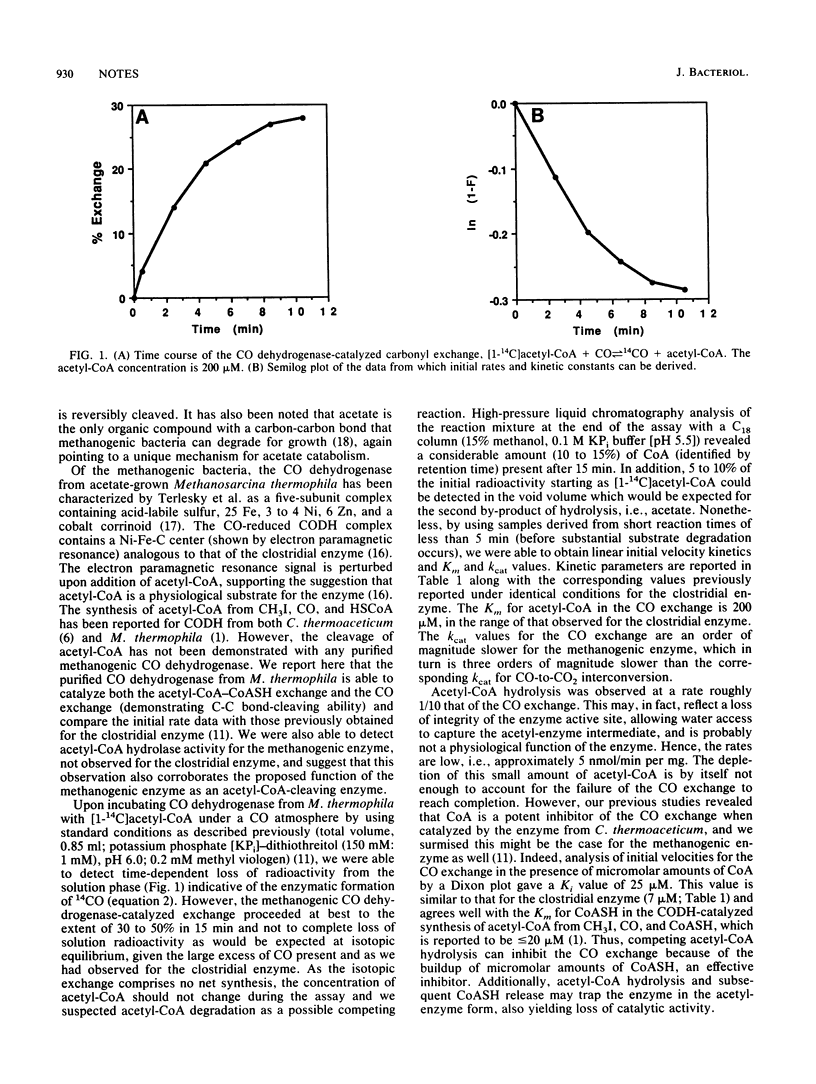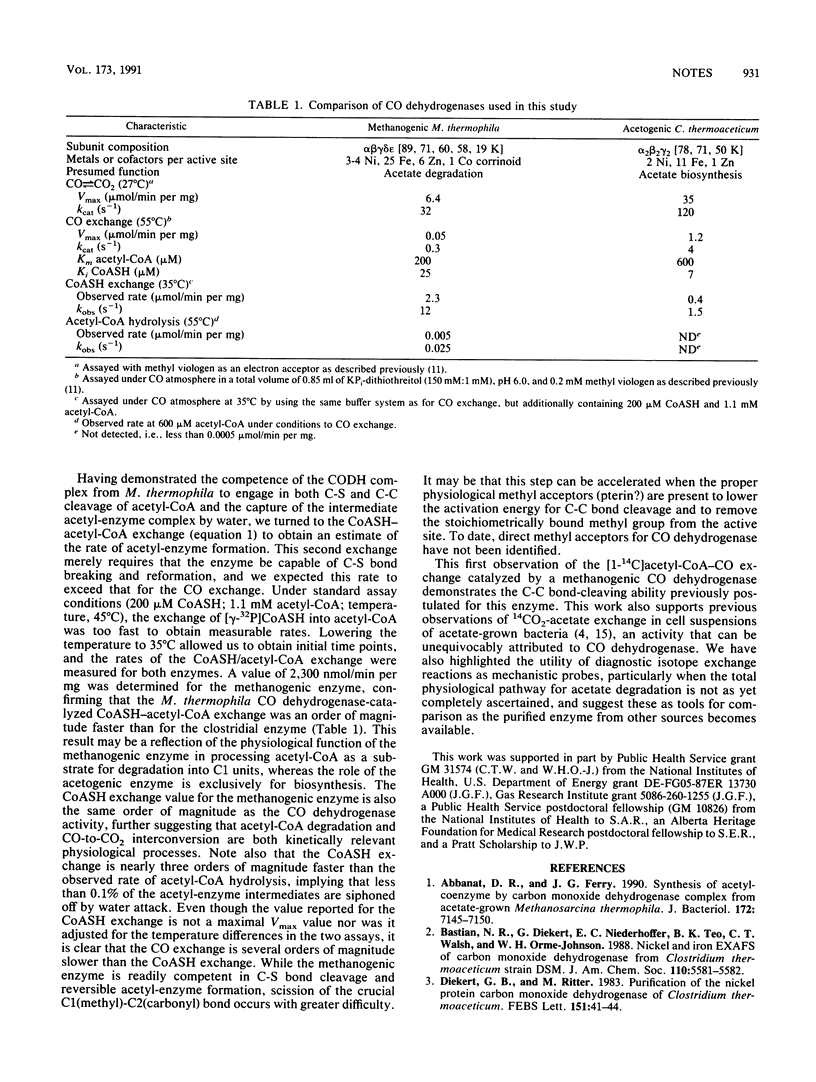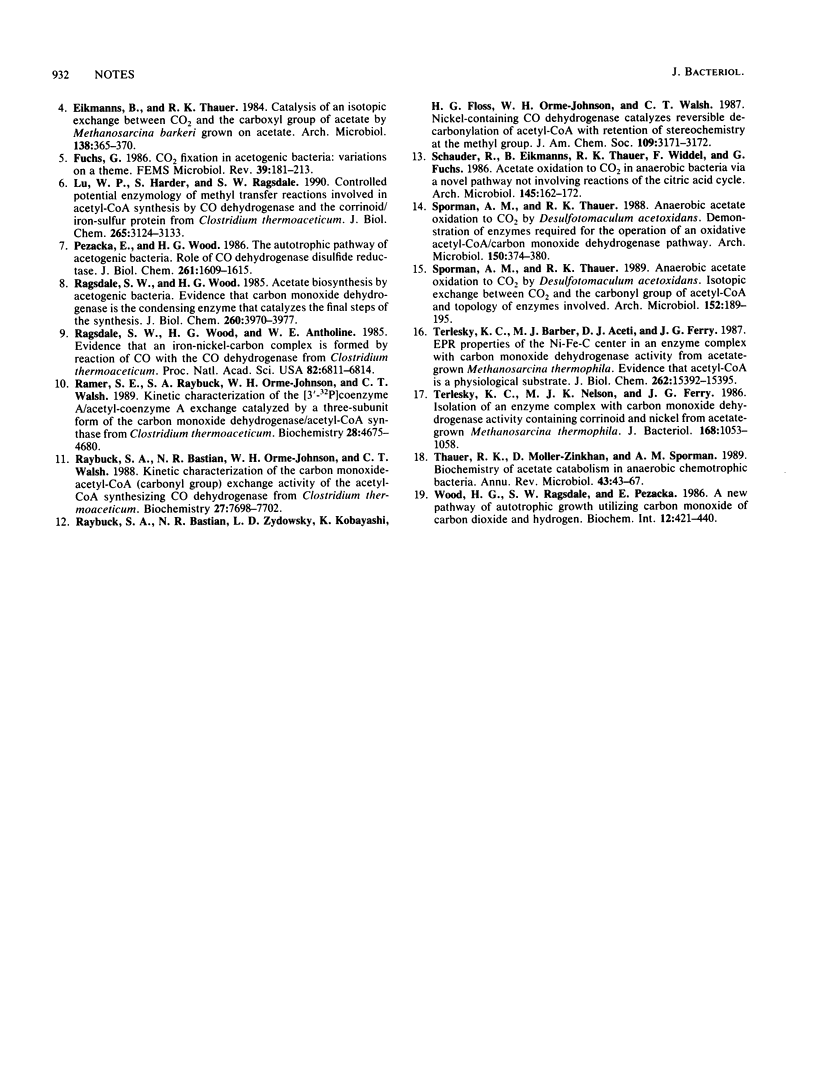Abstract
The purified nickel-containing CO dehydrogenase complex isolated from methanogenic Methanosarcina thermophila grown on acetate is able to catalyze the exchange of [1-14C] acetyl-coenzyme A (CoA) (carbonyl group) with 12CO as well as the exchange of [3'-32P]CoA with acetyl-CoA. Kinetic parameters for the carbonyl exchange have been determined: Km (acetyl-CoA) = 200 microM, Vmax = 15 min-1. CoA is a potent inhibitor of this exchange (Ki = 25 microM) and is formed under the assay conditions because of a slow but detectable acetyl-CoA hydrolase activity of the enzyme. Kinetic parameters for both exchanges are compared with those previously determined for the acetyl-CoA synthase/CO dehydrogenase from the acetogenic Clostridium thermoaceticum. Collectively, these results provide evidence for the postulated role of CO dehydrogenase as the key enzyme for acetyl-CoA degradation in acetotrophic bacteria.
Full text
PDF



Selected References
These references are in PubMed. This may not be the complete list of references from this article.
- Abbanat D. R., Ferry J. G. Synthesis of acetyl coenzyme A by carbon monoxide dehydrogenase complex from acetate-grown Methanosarcina thermophila. J Bacteriol. 1990 Dec;172(12):7145–7150. doi: 10.1128/jb.172.12.7145-7150.1990. [DOI] [PMC free article] [PubMed] [Google Scholar]
- Diekert G., Ritter M. Purification of the nickel protein carbon monoxide dehydrogenase of Clostridium thermoaceticum. FEBS Lett. 1983 Jan 10;151(1):41–44. doi: 10.1016/0014-5793(83)80338-x. [DOI] [PubMed] [Google Scholar]
- Lu W. P., Harder S. R., Ragsdale S. W. Controlled potential enzymology of methyl transfer reactions involved in acetyl-CoA synthesis by CO dehydrogenase and the corrinoid/iron-sulfur protein from Clostridium thermoaceticum. J Biol Chem. 1990 Feb 25;265(6):3124–3133. [PubMed] [Google Scholar]
- Pezacka E., Wood H. G. The autotrophic pathway of acetogenic bacteria. Role of CO dehydrogenase disulfide reductase. J Biol Chem. 1986 Feb 5;261(4):1609–1615. [PubMed] [Google Scholar]
- Ragsdale S. W., Wood H. G. Acetate biosynthesis by acetogenic bacteria. Evidence that carbon monoxide dehydrogenase is the condensing enzyme that catalyzes the final steps of the synthesis. J Biol Chem. 1985 Apr 10;260(7):3970–3977. [PubMed] [Google Scholar]
- Ragsdale S. W., Wood H. G., Antholine W. E. Evidence that an iron-nickel-carbon complex is formed by reaction of CO with the CO dehydrogenase from Clostridium thermoaceticum. Proc Natl Acad Sci U S A. 1985 Oct;82(20):6811–6814. doi: 10.1073/pnas.82.20.6811. [DOI] [PMC free article] [PubMed] [Google Scholar]
- Ramer S. E., Raybuck S. A., Orme-Johnson W. H., Walsh C. T. Kinetic characterization of the [3'-32P]coenzyme A/acetyl coenzyme A exchange catalyzed by a three-subunit form of the carbon monoxide dehydrogenase/acetyl-CoA synthase from Clostridium thermoaceticum. Biochemistry. 1989 May 30;28(11):4675–4680. doi: 10.1021/bi00437a025. [DOI] [PubMed] [Google Scholar]
- Raybuck S. A., Bastian N. R., Orme-Johnson W. H., Walsh C. T. Kinetic characterization of the carbon monoxide-acetyl-CoA (carbonyl group) exchange activity of the acetyl-CoA synthesizing CO dehydrogenase from Clostridium thermoaceticum. Biochemistry. 1988 Oct 4;27(20):7698–7702. doi: 10.1021/bi00420a019. [DOI] [PubMed] [Google Scholar]
- Terlesky K. C., Barber M. J., Aceti D. J., Ferry J. G. EPR properties of the Ni-Fe-C center in an enzyme complex with carbon monoxide dehydrogenase activity from acetate-grown Methanosarcina thermophila. Evidence that acetyl-CoA is a physiological substrate. J Biol Chem. 1987 Nov 15;262(32):15392–15395. [PubMed] [Google Scholar]
- Terlesky K. C., Nelson M. J., Ferry J. G. Isolation of an enzyme complex with carbon monoxide dehydrogenase activity containing corrinoid and nickel from acetate-grown Methanosarcina thermophila. J Bacteriol. 1986 Dec;168(3):1053–1058. doi: 10.1128/jb.168.3.1053-1058.1986. [DOI] [PMC free article] [PubMed] [Google Scholar]
- Thauer R. K., Möller-Zinkhan D., Spormann A. M. Biochemistry of acetate catabolism in anaerobic chemotrophic bacteria. Annu Rev Microbiol. 1989;43:43–67. doi: 10.1146/annurev.mi.43.100189.000355. [DOI] [PubMed] [Google Scholar]
- Wood H. G., Ragsdale S. W., Pezacka E. A new pathway of autotrophic growth utilizing carbon monoxide or carbon dioxide and hydrogen. Biochem Int. 1986 Mar;12(3):421–440. [PubMed] [Google Scholar]


